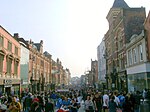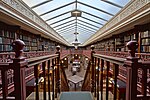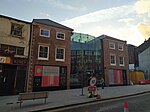Battle of Leeds
The battle of Leeds took place during the First English Civil War on 23 January 1643, when a Parliamentarian force attacked the Royalist garrison of Leeds, Yorkshire. The attack was partly dictated by the need to maintain local support for the Parliamentarian cause; the Earl of Newcastle had recently shifted the balance of power in Yorkshire in the Royalists' favour with the addition of his 8,000-strong army, and sent one of his commanders, Sir William Savile to capture Leeds. The West Riding of Yorkshire relied on the cloth trade, and Ferdinando, Lord Fairfax sent his son, Sir Thomas Fairfax to bolster the defences of nearby Bradford, before agreeing to his request to attack Leeds. Savile, who had command of around 2,000 men in Leeds, built a trench on the western edge of Leeds, destroyed one bridge on the approach to the town and heavily fortified another. Fairfax attacked during a heavy snowstorm, bringing an army of roughly 3,000 men to attack Leeds in three places. The battle lasted around two hours before the Parliamentarians secured the town, and captured about 500 prisoners. Fairfax lost around 20 men during the attack, while the Royalists suffered roughly double as many fatalities.
Excerpt from the Wikipedia article Battle of Leeds (License: CC BY-SA 3.0, Authors).Battle of Leeds
Briggate, Leeds Lovell Park
Geographical coordinates (GPS) Address Nearby Places Show on map
Geographical coordinates (GPS)
| Latitude | Longitude |
|---|---|
| N 53.7969 ° | E -1.5424 ° |
Address
Marks & Spencer
Briggate 47-49
LS1 6HF Leeds, Lovell Park
England, United Kingdom
Open on Google Maps










